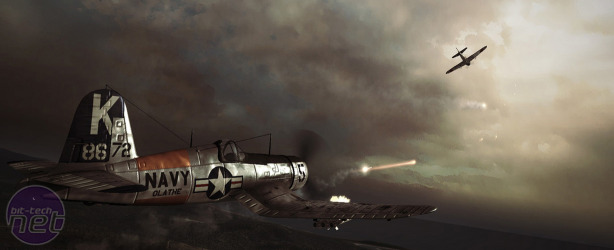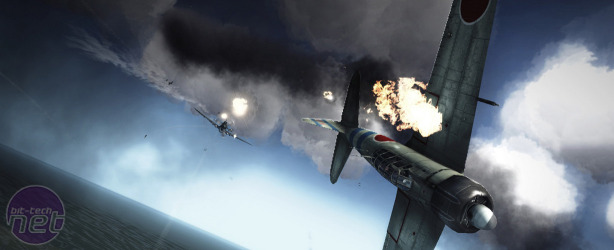Damage Inc. Pacific Squadron WWII review
August 30, 2012 | 07:50
Companies: #mad-catz #trickstar-games

Damage Inc. Pacific Squadron WWII
Publisher: Mad Catz Interactive
Platform: Xbox 360, PS3, PC
UK Price (as reviewed): £39.99 Incl. VAT, with Saitek Pacific AV8R Flightstick: £69.13 Incl. VAT
US Price (as reviewed): $49.99 Excl. Tax, with Saitek Pacific AV8R Flightstick: $99.99 Incl. VAT
Piloting a fighter plane must be an exhilarating combination of pure concentration and raw adrenaline - an experience that should translate well into computer game form. Turns out planes are pretty hard to control though, leaving devolopers with two options. The first is to dumb the controls down quite a bit and make a simulation, while the second is to dumb them down a hell of a lot and make an arcade game.
It may have both Simulation and Arcade control setups (the difference being that Arcade doesn't allow you to use the plane's rudder, which feels weird and restrictive and in our humble opinion should never be used), but Damage Inc. Pacific Squadron WWII isn't worried about recreating the finer points of air combat. No matter which setting you use there's no need to worry about running out of ammo or fuel, landing at the perfect trajectory or limiting your use of the two special manoeuvres: Warspeed (boost) and Reflex Mode (slow-motion).

Despite Damage Inc. taking an arcade approach to proceedings, it fails to capitalise on the pulse-racing potentials of ignoring the rules of physics. Instead of nail-biting aerial pursuits, it has yawn-inducing encounters that have more in common with sloth and turtle than cat and mouse, made worse by awful controls, which despite their simplicity are infuriatingly jittery.
It’s shocking how poor the controls are, especially when you consider that Damage Inc. is being published by Mad Catz to promote its own flightstick peripheral. We used their AV8R flightstick at first and found it impossible to turn without rolling. After switching to a regular controller we mastered the basics of flying and got through the first few missions. We then tried the flightstick again and though much better than our first attempt, it was still a horrible experience.

Due to the flightstick's size, constantly readjusting trajectory requires exaggerated movements, while the left and right yaw buttons (LB and RB on a normal controller) that turn the plane's nose are located at the stick's base along with the throttle, requiring more than the one free-hand you have to be used simultaneously. Warspeed, normally activated by pressing the throttle button twice (RT on a normal controller) is vital for intercepting distant enemies, but we couldn’t get it to work at all. All of which is a shame, as the flightstick is pleasingly chunky and certainly looks the business.
Whatever controller/control method you choose, after you've got the hang of flying the next step is combat. A red target dot sits ahead of enemy planes and marks where to shoot, requiring you to line up your sights with it to make contact. The resulting experience manages to have more in common with a wire loop game than any air-based battles we can recall.
Publisher: Mad Catz Interactive
Platform: Xbox 360, PS3, PC
UK Price (as reviewed): £39.99 Incl. VAT, with Saitek Pacific AV8R Flightstick: £69.13 Incl. VAT
US Price (as reviewed): $49.99 Excl. Tax, with Saitek Pacific AV8R Flightstick: $99.99 Incl. VAT
Piloting a fighter plane must be an exhilarating combination of pure concentration and raw adrenaline - an experience that should translate well into computer game form. Turns out planes are pretty hard to control though, leaving devolopers with two options. The first is to dumb the controls down quite a bit and make a simulation, while the second is to dumb them down a hell of a lot and make an arcade game.
It may have both Simulation and Arcade control setups (the difference being that Arcade doesn't allow you to use the plane's rudder, which feels weird and restrictive and in our humble opinion should never be used), but Damage Inc. Pacific Squadron WWII isn't worried about recreating the finer points of air combat. No matter which setting you use there's no need to worry about running out of ammo or fuel, landing at the perfect trajectory or limiting your use of the two special manoeuvres: Warspeed (boost) and Reflex Mode (slow-motion).

Despite Damage Inc. taking an arcade approach to proceedings, it fails to capitalise on the pulse-racing potentials of ignoring the rules of physics. Instead of nail-biting aerial pursuits, it has yawn-inducing encounters that have more in common with sloth and turtle than cat and mouse, made worse by awful controls, which despite their simplicity are infuriatingly jittery.
It’s shocking how poor the controls are, especially when you consider that Damage Inc. is being published by Mad Catz to promote its own flightstick peripheral. We used their AV8R flightstick at first and found it impossible to turn without rolling. After switching to a regular controller we mastered the basics of flying and got through the first few missions. We then tried the flightstick again and though much better than our first attempt, it was still a horrible experience.

Due to the flightstick's size, constantly readjusting trajectory requires exaggerated movements, while the left and right yaw buttons (LB and RB on a normal controller) that turn the plane's nose are located at the stick's base along with the throttle, requiring more than the one free-hand you have to be used simultaneously. Warspeed, normally activated by pressing the throttle button twice (RT on a normal controller) is vital for intercepting distant enemies, but we couldn’t get it to work at all. All of which is a shame, as the flightstick is pleasingly chunky and certainly looks the business.
Whatever controller/control method you choose, after you've got the hang of flying the next step is combat. A red target dot sits ahead of enemy planes and marks where to shoot, requiring you to line up your sights with it to make contact. The resulting experience manages to have more in common with a wire loop game than any air-based battles we can recall.

MSI MPG Velox 100R Chassis Review
October 14 2021 | 15:04









Want to comment? Please log in.